The First PTEs - SHMD Board
The First PTEs - SHMD Board
Not read from the beginning, click here
There were no fewer than 11 operators absorbed by SELNEC. Eighth in size and possibly the most odd in many respects was the Stalybridge, Hyde, Mossley and Dukinfield Transport and Electricity Board, so a few paragraphs about the operator are in order.
Set up by an Act of Parliament initially to facilitate the production and distribution of electricity followed by the provision of a tramway in the four Municipal Boroughs to the east of Manchester, the Board had been a tram operator from 1903.
The word "Electricity" remained in the title until the end, even though the 1949 nationalisation of electricity supply had taken away that function, more because the substitution of the word "Transport" for "Tramways" in 1936 had needed an expensive Act of Parliament, another of which would have been needed for any further change, rather than the word remaining as a nod towards the Board's involvement in trolleybus operation.
Of the four Boroughs, three were in Cheshire and Mossley was in Lancashire. The order of names is interesting. Stalybridge was always seen as the leading constituent and the depot, or more accurately, shed and yard were in that town. It also was the only town with boundaries with all the other Board constituents. The order of the rest of the towns seems to be down to serendipity
Dukinfield is marginally the most westerly of the Boroughs lying to the south of Ashton. Further east and south is Hyde, the largest of the Boroughs, with a toehold in the Pennine foothills, whilst Stalybridge is tucked under the edge of those hills with links along valley roads to Mossley. The pre 1974 boundaries of the Pennine edges meant that the Board's buses, at the time of absorption into SELNEC, ran in no fewer than four counties and its routes were on the roads of one City, two County Boroughs, six Boroughs and three Urban Districts.
SHMD was a loyal customer to its suppliers. Thorneycroft was the chosen bus chassis until they ceased production and Northern Counties built the bodies. Daimler replaced Thorneycroft and provided the majority of chassis for both single and double deckers. There was a brief love affair with Atkinson which resulted in the only double deck Atkinson as well as a number of single deckers. Only Massey, Brush and East Lancs disturbed the flow of orders for Wigan built bodies, due solely to supply problems during and after World War Two.
With a history of "home grown" General Managers it was a surprise when Frank Brimelow was appointed from Middlesborough in 1957. He bought three batches of his favoured PD2/Northern Counties combination and changed the colour scheme before leaving for Stockport five years later, after which the old vehicle order was restored.
At the end, with the industry in trouble with its rear engined single deck chassis, Bristols appeared in the fleet and there would doubtless have been more.
Half the buses were kept outside in the depot yard, though batches spent long periods parked around the system in Hyde and Ashton. Frank Brimelow upgraded the yard facilities to include battery chargers, cab and radiator heaters to keep the vehicles frost free, very much a requirement when starting on cold, dark, Stalybridge winter mornings.
As for trolleybuses, SHMD didn't operate any though an intriguing "photo" on page 91 of "The Manchester Trolleybus" shows what a three axle chassis/Northern Counties combination would have looked like in the Board's colours. This is based on research that shows Sunbeam listed SHMD as a customer in a 1940 brochure and ten bodies diverted to Cardiff on AEC chassis had been in build for SHMD. As it was SHMD owned the poles, distribution equipment and overhead for the Manchester - Gee Cross and Manchester to Stalybridge routes, from the Hyde and Stalybridge boundaries respectively though these were never to Manchester's standard and were the subject of a number of acrimonious exchanges.
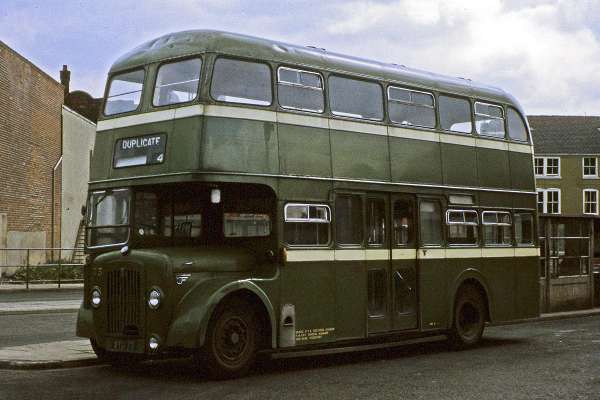
Under L G Stockwell, centre entrances became a passing fad. The sole Atkinson double decker is well known. Less published are photos of the Daimler centre entrance batch. Still bearing fleet number 73, VTU 73 is a 1956 Daimler CVG6 with a H35/32CD body and looks rather sorry for itself in what looks to be Stalybridge Bus station. 73 became 5673 but didn't have a real future in the fleet.
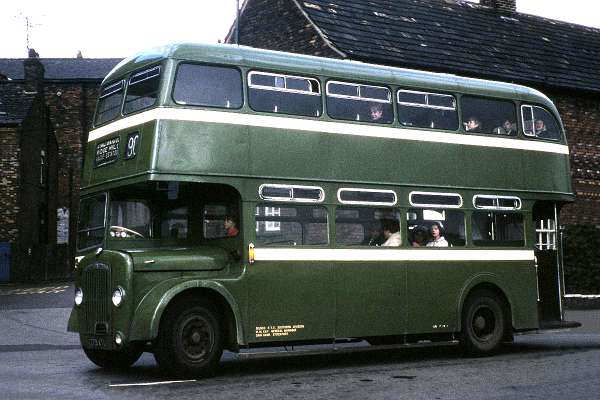
With SELNEC Southern legal lettering and looking particularly dull, 279 ATU a 1957 Daimler CVG6/Northern Counties H36/28R had been upseated from H33/28R in 1963. Once 79 in the SHMD fleet and, when photographed at an unknown location, numbered 5679 with SELNEC, the standee windows were a feature of Frank Brimelow's orders. Like all front engined SHMD double deckers, this vehicle featured a bell cord on the lower deck.
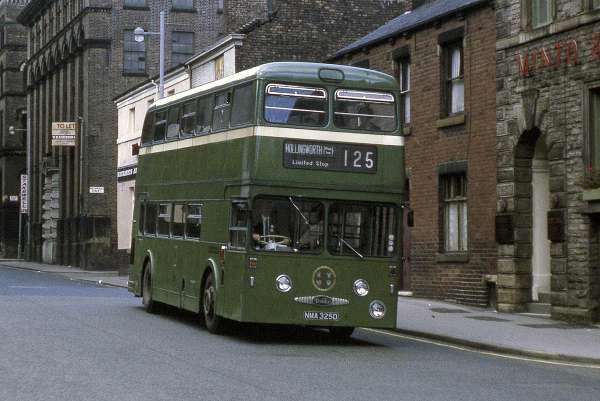
James Wood, a long time SHMD employee, took over from Frank Brimelow and returned to Daimler with an order for six CVG6s delivered in 1964 with the first forward entrance bodies in the fleet. CRG6LX Fleetlines appeared in 1965. Nine were delivered that year with the remaining sixteen in 1966 and, whilst there was just one order, most publications treat them as distinct batches. NMA 325D, fleet number 25, was the fourth of the second batch with standard NCME H43/31F bodywork including panels above the engine to disguise the bustle. The Fleetlines saw a minor change in the colour scheme with the deletion of the cream stripe under the lower deck windows. Previously the large SHMD Board titles on the lower deck side panels, with the words divided by the circle enclosing the four Borough coats of arms, had been replaced by smaller gold titling above the front wheel arches, or on the foremost panels on front engined vehicles. Just visible in this picture behind the side indicator the titles, which took two lines, read "Stalybridge, Hyde, Mossley and Dukinfield Transport Board". The white lettering on the gold circle read "SHMD Board". Fleet number 25, seen here crossing the then partly hidden Rochdale Canal on Princess St Manchester on a 125 limited stop short working, became SELNEC's 5625 surviving well into GMT's ownership. The 125 was joint with Manchester and North Western and was the via Hyde alternative to route 6 to Glossop which went via Ashton and in which latter, Ashton Corporation also participated.
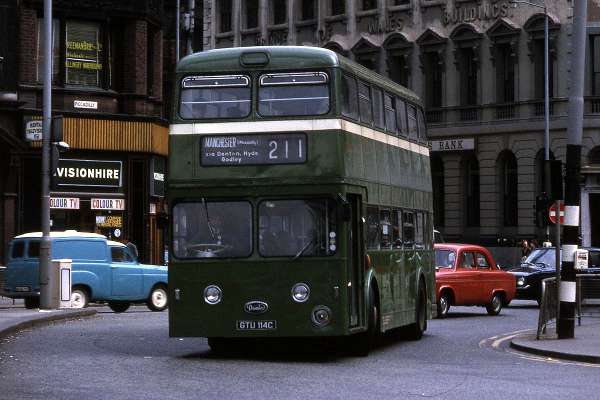
Devoid of fleet number, fleet name, coats of arms or anything else other than legal ownership details to advise passengers of the operator and with the fluted wings missing from the Daimler badge, GTU 114C, 5614 in SELNEC's inventory and originally 14 with SHMD, enters Portland St., Manchester at the end of its journey from Hattersley, a Manchester overspill area between Hyde and Mottram. Joint with Manchester but not, to the Stockport's concerns annoyance, with North Western, the route number is in the Manchester trolleybus series but no trolleybus ever reached Hattersley. The number was originally allocated to the Stevenson Sq. to Greengate via Moston trolleybus service which headed away from Manchester at almost ninety degrees to its later incarnation. The logic of the reallocation was that the 210 served Gee Cross via Hyde and the 211 used the same route as far as Hyde town centre.
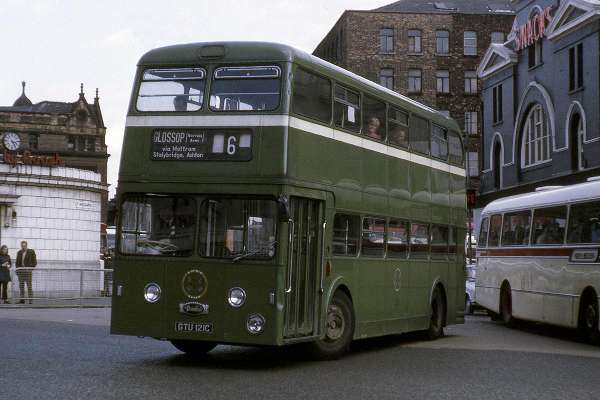
The Daimler badges seemed to do badly on the first batch. GTU 121C leaves Lower Mosely St on route 6 for Glossop still in full SHMD livery and legal lettering with vestiges of the fluted wings still in situ.
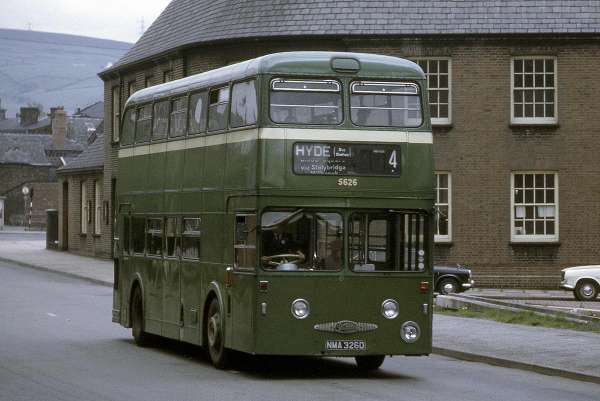
NMA 326D has received its SELNEC fleet number but little else to identify it. On route 4 from Mossley to Hyde, the bus is in Stalybridge. The mudguards on this design always looked like an anachronism. It is understood that all but one of the vehicles delivered in 1965/1966 survived well into GMT days, the exception was reportedly a fire victim.
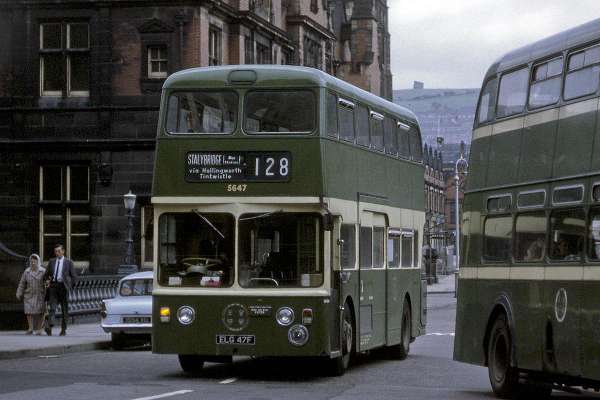
The last double deckers were again Fleetlines, but just that bit different. ELG 47F was a 1967 delivery based on Edgely Cox's 27 foot long design for Walsall and had Gardner 6LW engines, being designated as CRG6LW. They had H41/27D NCME bodies which featured a narrow front door and a sliding central exit. Seen here on route 128, one of a variety of routes linking Glossop and Stalybridge, it is operating in OMO configuration - something which was only partially successful due to the time taken at bus stops with the driver collecting fares opposite a one person wide entrance. 5647 was originally 47 in the SHMD fleet and was the last double decker ordered. A slightly lighter green and much more cream was employed and, number and legal lettering apart, the bus is as delivered. Roger has not provided any pictures of SHMD vehicles in SELNEC's livery. This isn't surprising given the date of his trip as Stalybridge not only painted an all Leyland PD2 from Stockport in green when it was transferred in 1970 but also painted no less than eight of Frank Brimelows 1958 and 1962 Titans in green and cream in 1971 in an attempt to use old paint stocks. The Fleetlines went on into the 1980s with GMT.
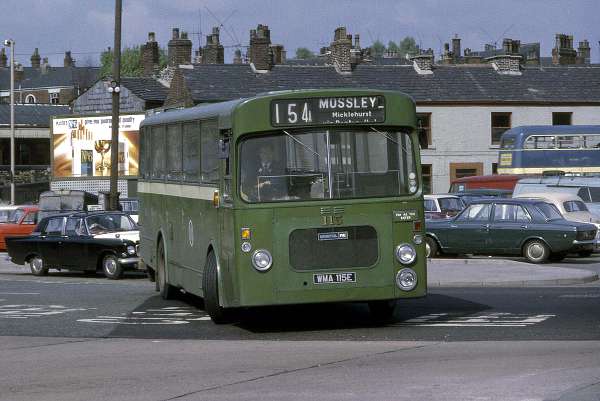
SHMD's last single deckers were two batches of Bristol RESLs. Unlike Stockport's almost defiant ordering of Bristol VRTs, the order for two batches of three was a matter almost of desperation for the Board given they needed a medium capacity saloon with as few problems as possible. Of the single deck fleet, all but the 1969 Atkinsons were coming to the end of their lives, though a few made it into the SELNEC fold and the solitary Daimler Freeline had its life stretched to 1969. The industry seemed to be in single decker meltdown, especially if a Gardner engine was needed, so the advent of the Bristol marque on the free market after almost twenty years must have been a welcome moment. Why the single deck Fleetline wasn't up to the job is a bit of a mystery but three RESL6Gs arrived in the first half of 1967. WMA 115E, fleet number 115, is turning into Ashton Bus Station with its blind set for its return via a circuitous but picturesque route to Mossley, under OMO configuration. All these vehicles had attractive deep side windows and a pleasing rear profile but the shape of the heavy front dome and curvature of the top of the windscreen, coupled with the radiator grille shape always reminds me of a frowning anthropomorphic cartoon vehicle!
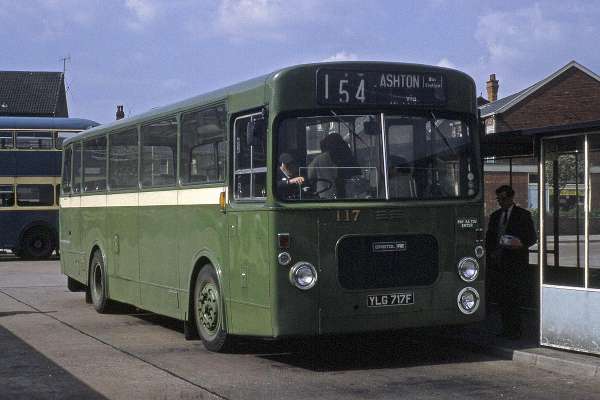
In contrast to 115 above 117, YLG 117F, from the second batch is devoid of any operator markings. The batch was seated as B43F and survived into the GMT fleet.
Before Ashton had a purpose built bus station SHMD had two termini in the town. Buses bound through Dukinfield would leave from a point adjacent to the Ashton Corporation Transport Office by the Town Hall - a point shared with route 6 to Glossop and the joint, with Ashton and Stockport, route 30 to Stockport Edgeley. The routes to Mossley and other points east, generally single deck operated, would leave from St Michael's Sq, inconveniently situated on the eastern edge of the town - a long way away from the shops to be carrying heavy shopping bags! Here in the 1950s could be found a cornucopia of NCME bodied Daimler COG5s (B38R) from 1938, 1950 CVD6s (B35R), the sole G6H (B34C) and the standee centre entrance Atkinsons that followed.
Copy by Phil Blinkhorn - Photographs by Roger Cox
08/2013
Click here to view Part Three - Stockport Corporation
09/08/13 - 12:37
Thanks for an evocative tribute to one of my favourite operators. SHMD had character far beyond what an examination of the fleet list would indicate; as you said there was a policy of standardisation but it somehow resulted in a lot of variety!
79 was, I believe, the last bus repainted in green in early 1970. The batch was being re-certified and the remainder of the batch was turned out in orange. Although it was allocated the SELNEC number 5679 it never carried it, running as 79 until withdrawal in early 1974. It still wasn't the last bus to run with its SHMD fleet number, as PD2 4 made it into GMT days as such!
In SHMD days the Fleetlines didn't carry fleet numbers at the front, only on the side beneath the SHMD monogram and at the rear. It was not unknown for them to carry the SELNEC number at the front and the SHMD number on the side! It was the last of the single-door Fleetlines, 37, which was burnt out in Mossley early in its life. The charred remains lay in the Tame Street Yard for some time before being gradually dismantled as shown in the photo.
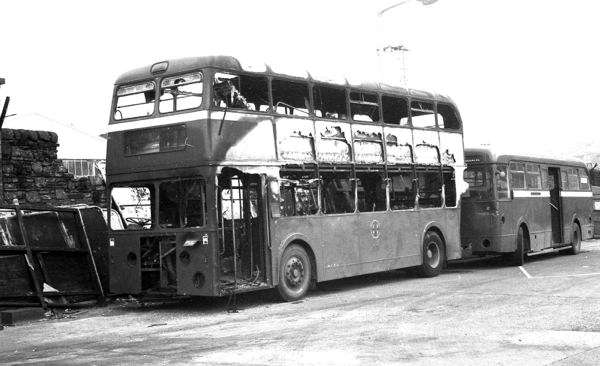
The single-door Fleetlines are all in original condition in these photos. They were gradually converted for one-man operation and ended up with a flap below the nearside windscreen like those seen on the short Fleetlines and REs - note that burnt-out 37 already has this. They all acquired a second (offside) foglight later in life, probably on first recertification from 1972 onwards.
The SHMD PD2s that were repainted green in SELNEC days were not done so to use up paint stocks, in fact new paint had to be bought from Mason's and it wasn't exactly the same shade. This was something we discovered when preparing preserved 76 for the 1972 Trans-Pennine Run with two painters at work using different tins of paint - they didn't match! The reason was that they were only being re-certified for a limited period and were only given a single coat. To repaint into orange would have been much more expensive as several coats were required to ensure proper coverage.
The REs were a good buy and spent most of their lives on the 154/154A services, which were restricted to single-deck operation due to a low arched bridge at Black Rock, between Stalybridge and bottom Mossley. SHMD double-deckers carried a notice in the cab specifically prohibiting them from going under this bridge. However, they could get through, as the double-deck trams had once done, in the middle of the road and in more recent years the layout has been modified using traffic light control to route all traffic through the centre of the arch. I think it saw several lorry strikes but I'm not aware of any buses hitting the bridge. RE 117 still survives today although as yet unrestored.
One route from Dukinfield also used St. Michael's Square, the 11 which was complicated Y-shape route. This approached Ashton from the eastern end so it was logical. The new bus station opened in 1963 but the services using St. Michael's Square didn't move until 1967 as the operators were in dispute with Ashton about high charges for using the new bus station, as well as the cost of the additional mileage.
The SHMD depot saw buses from a surprising number of SELNEC/GMT constituents working from there: buses from Stockport, Ashton, Oldham, Bury, Manchester, Salford, North Western and Wigan have been recored. Quite a few of these, including the Wigan vehicles as late as 1977, were still in pre-PTE livery adding to the variety.
David Beilby
09/08/13 - 15:29
David, thanks for adding so much and especially for the photo. Growing up in Ashton and Stockport I got to both see and ride on much of the fleet which was by far the most individual in the area for all its loyalty to its suppliers.
My interest in the "Joint Board" goes back to pre-school days. Possibly because the fleet just looked "different" to all the other offerings in Ashton.
I have a memory of riding on a Thorneycroft Cygnet from St Michael's Square which, judging by the withdrawal dates and when we first had a car, must have been in 1952. I vividly remember the double decker COG5s and will have seen the Darings, though I can't claim to remember them.
Phil Blinkhorn
09/08/13 - 15:30
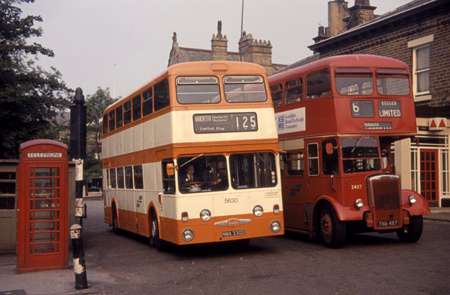
Pictured here in Glossop is former SHMD Fleetline 30 (NMA 330D), by then masquerading as SELNEC Southern 5630, alongside SELNEC Central's ex-Manchester 3487, a Burlingham-bodied Leyland PD2/40. (Sunday 2nd September 1973)
John Stringer
10/08/13 - 06:10
In fairness the Fleetline was one of the body styles that didn't look too bad in the SELNEC livery though the painting of the mudguards makes them look even more odd than in the original scheme.
In contrast the PD2, nearly 4 years after vesting day, leaves a lot to be desired.
Phil Blinkhorn
10/08/13 - 06:11
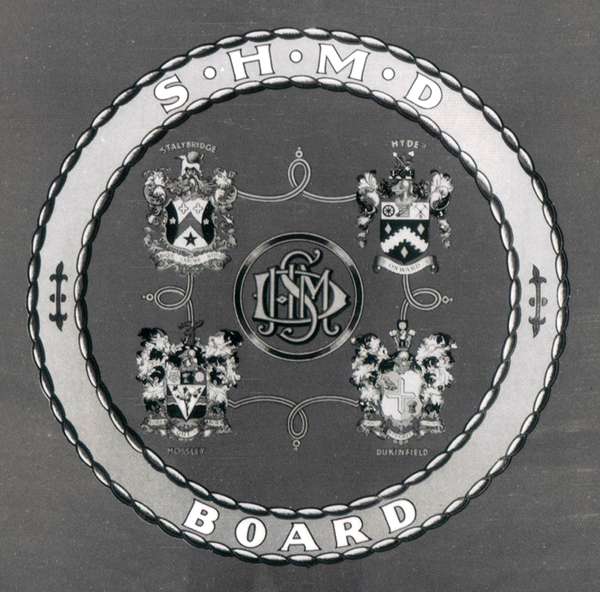
I used to live at Dacres on the 154 service, jointly operated with North Western Road Car Co Ltd, and remember travelling on the 'Joint Board' vehicles.
The over riding memory of SHMD (well for me anyway) was that they always seemed to well turned out.
The crews were always smart, with their blue serge uniforms with Green piping on trousers and tunics, and in the Summer White Cap covers to their caps.
Please find attached a picture I have of the SHMD Crest.
There weren't many Bus Company Crests/Coats of Arms as ornate as this, it exuded Municipal pride.
Stephen Howarth
11/08/13 - 06:55
Re John's photo at Glossop, I am surprised to see a 16-year-old PD2 out on a Sunday at all, regardless of the state of it. One of the main reasons for the longevity of Manchester buses was that only about a third of them were doing a full week's mileage at any one time, the remainder being confined to peak hours and (in the football season) Saturday afternoons. 3487 has the air of having been turned out in something of a hurry, even by Manchester standards!
Peter Williamson
16/09/13 - 17:20
I've always thought the story of the diverted SHMD trolleybuses something of an enthusiast's fantasy, probably based on some misunderstanding.
None of the trolleybus routes went anywhere near an SHMD depot, which would have made operating such vehicles impossible except at wholly disproportionate cost, and SHMD were never known for being profligate with their cash. Neither Hyde (due for closure when the trams ceased)nor Stalybridge could easily accommodate trolleys, being dead-end sheds, and was SHMD really going to wire a link from the depot to Stalybridge or Stamford Park to accommodate three or four dead trips a day? It was much too far for traction batteries.
Also, six trolleys was far too many for SHMD's share of the Manchester-Stalybridge joint route,of which only 3/4 mile was in Stalybridge and, even if the rest were intended for the Hyde Road routes which were not converted due to the outbreak of war, getting from Stalybridge onto the Hyde Road section would have meant either a vast amount of empty running, or interworking the Stalybridge-Manchester and Hyde Road or Denton services -a scheduling nightmare!
And if SHMD was going to buy trolleys, why Sunbeams? That marque was then virtually unknown in the North, Daimler offered a perfectly good trolley which had much in common with the COGs on which SHMD were standardised, and, failing that, Leylands or Crossleys, both used by Ashton and Manchester, would have been a more sensible choice given that there was a mutual aid pact in case of breakdown.
In any case, the fact is SHMD never needed to operate trolleys; they had a wide choice of joint routes on which they could work off their share of the mileage, and this is what they did; routes, bus workings or individual journeys were swapped between operators periodically to balance their mileage share, a process that worked perfectly well between all the operators in the Manchester area for decades. What sane transport manager would go through the hassle and expense of trying to operate six trolleys?
And while I'm on my soapbox, does anybody actually have proof that the SHMD short Fleetlines were 6LW powered? I know the Walsall ones were, but the SHMD vehicles never seemed short of power to me as a passenger, and it's always struck me as unlikely that the same management who specified the 6HLX in a 43-seat Bristol RESL would then go on to order 68-seat double-deckers with an engine having 2 litres less capacity. Something just doesn't ring right here?
David Jones
17/09/13 - 11:29
The year lists for 1968 show SHMD's last DD's (chassis nos 62733-42) as being CRG6LX's though Peter Gould records them as LW's in which case they were a great rarity in that period as I cannot find any other Fleetlines so designated. Indeed all Fleetlines delivered in 1968 appear to be of the LX variant except some LXB's delivered to Leeds.
Orla Nutting
17/09/13 - 11:30
David, the short Fleetlines were 6LW powered as per the Walsall examples. Every reference I've ever seen, inc Peter Gould's fleet list, states 6LW.
The trolleybus saga is a real mystery shrouded by the fog of war. There is certainly no minute or other indication of an order with Sunbeam, Northern Counties or anyone else but there are indications that some sort of exploratory discussions and maybe even an informal agreement existed but no firm evidence has been found.
On the point of would the Board have run trolleybuses had the war not intervened, none of the reasons you postulate hold too much water. The Board was primarily an electricity producer and the tramway and bus networks were an historical spin off. Nationalisation of electricity supply and distribution was but a pipe dream of the more radical socialist thinkers in 1939, thus conversion of parts of the ageing tram system would have been a distinct possibility.
Eyre and Heaps in "The Manchester Trolleybus" state that ten vehicles would have been reasonable for its share of the converted 19 tram service, though six was thought to have been in mind when SHMD stated in the 1939 agreement with MCTD that the operation would be joint. Seemingly this implied joint running. Apart from the Hyde route, the route to Manchester via Ashton would have been a certainty and the route from Stalybridge to Moseley, which passed the Board's own power station, would have been another possibility.
Of course we will never know for certain. The decision makers of the time are long dead. Their minutes and any other surviving documentation tells us little and only serve to confuse.
Phil Blinkhorn
17/09/13 - 13:50
It is certainly correct that many of Walsall's short Fleetlines were LW powered but the final batch in 1968 (the same year as the SHMD vehicles were delivered) were definitely LX powered. 116 is preserved at Wythall.
Orla Nutting
17/09/13 - 17:51
Orla, the SHMD Fleetlines 38-47, ELG 38-47 are shown by Peter Gould as 1967 deliveries but ELGxxxF was issued from May 1968 onwards. What we need is someone with back issues of Buses Illustrated to confirm.
Phil Blinkhorn
17/09/13 - 19:07
Daimler Fleetline (Gavin Booth) p18 says that 69 of Walsall's short Fleetlines were 6LWs. It then says other customers for double deck 6LWs were Grimsby-Cleethorpes, Middlesborough and Teesside. The SHMD buses are mentioned but not in connection with 6LW power.
David Oldfield
17/09/13 - 19:09
The 'Buses on the Web' listing was the source of my understanding that the SHMD vehicles may have been LX powered. The Walsall vehicles are also shown as LX powered though I've seen at least one other attribution of 116 as being LXB powered now: possibly a post introduction upgrade?
Orla Nutting
18/09/13 - 15:34
The first four years of the year suffix registration number system saw letters issued for the calendar years 1963 (A), 1964 (B), 1965 (C) and 1966 (D). Letter E was issued for just 7 months between January 1 and July 31 1967.
From 1 August 1967 the period covered by a particular suffix letter was between 1 August and 31 July each year through into the era of the prefix letter system. The main reason given for this change was that the motor trade was deluged with orders for new cars over the busy Christmas and New Year period as customers wanted vehicles with the 'new letter'.
Therefore suffix letter F was issued from 1 August 1967 to 31 July 1968.
I followed up Phillip's suggestion that someone with back issues of 'Buses Illustrated' might look up the SHMD Fleetlines. The 'Fleet News' column of the September 1968 issue carried the following report: "STALYBRIDGE. The Walsall style short Daimler Fleetlines with Northern Counties H41/27D bodies are 38-47 (ELG 38F, etc). They have single-width front entrances and a sliding door to the exit, which is just behind the front axle. Fitted for one-man operation, they are in use on route 6 (Manchester, Stalybridge and Glossop) with a crew of two." There is no mention of the engine size/type. In those days fleet news reports took longer to get into print than they do today so by September 1968 the buses would have been in service for a few (couple or so?) months.
Alan Witton's 'Greater Manchester Transport' fleet book (April 1974) quotes the buses as 'built 1968' whereas the British Bus Publishing '1968 North West Bus Handbook' (published in 2000) simply shows a date '1967'.
Whilst I don't think this applies to the registering of the SHMD Fleetlines as they were already in service by 1 August 1968 when the G suffix plates began, on the subject of registrations generally records for vehicles might vary between the date a vehicle was actually built and the date it was registered. To get a 'new letter' on a number plate vehicles were often stored for a time before being put on the road. This aspect wasn't necessarily of concern to a big bus operator and, although I cannot now remember which they were, I do recall there being cases of new buses entering service during the month of July simply because the buses were needed. There was no regard for the vanity of waiting for a 'new letter' plate. (There have also been instances where an allocated registration number issued prior to the changeover date was surrendered in favour of obtaining one with a new letter with the vehicle not entering service until an August date).
Consideration was/is also given to the economics of taxing vehicles. As we all know, taxing a vehicle from the first of the month rather than in the final days of a month gives extra value for money. Even prior to the year prefix system new buses may be delivered but not taxed until the date was right. I remember quite well visiting the Todmorden JOC garage on December 31 1963 and seeing new gleaming East Lancs bodied Leyland Leopards 572/573 EYG waiting to enter service in the forthcoming days of the New Year. The June 1964 edition of the Ian Allan 'British Bus Fleets - Yorkshire Municipal Operators)' book quotes the pair as 'built 1963' whereas Bus Lists on the Web and the PSV Circle show 1964 which is the date into service so I suppose it is all a matter of interpretation.
There weren't that many registration authorities issuing A suffix plates in 1963 and with some it was well into 1964 before they switched from numbers in the old format to issuing B suffix plates. (For example West Riding of Yorkshire in the case of the aforementioned TJOC buses and Rochdale for the spring 1964 deliveries to Yelloway which were 7071-7076 DK).
David Slater
PS - I have just found a copy of an official fleet list issued by SHMD dated 24 September 1968 which I never realised I had! Fleetlines 38-47 are shown as 'Date purchased June 1968' and the engines as being 'Gardner 6LX'.
18/09/13 - 17:40
I agree that the 1968 North West Bus Handbook does list the Fleetlines as delivered to SHMD in 1967 and that they were LW powered but I think that it could be an error.
I believe that it's reasonable to assume that the SHMD Fleetlines were actually delivered sometime between April 1968 and July 1968 as the Northern Counties body numbers are all higher than the last of the 1968 LX powered Walsall Fleetlines, delivered in March 1968 (4 more were delivered to Walsall in Dec 68).
Orla Nutting
19/09/13 - 10:16
David, that fleet list looks to have nailed it and puts into question Peter Gould's work both in terms of the date and engine type which means any other info in his fleet lists needs checking before being taken as gospel.
As a further illustration and on the subject of registration dates, Manchester had a batch of Fleetlines 4701 to 4761, all ordered in one batch but, due to extended delivery times, delivered over a 14 month period. These had split registrations, 4701-4730 being registered as DNF701C-DNF730C in December 1965, though DNFxxxC was issued between September and November 1965. 4701-4706 were delivered in December 1965 but did not see service until January 1966. 4707-4712 were delivered in January 1966, 4713-4730 were delivered during February 1966. Peter Gould has them all as 1965 vehicles.
FNE731D-FNE740D,4731-4740, were delivered in December 1966 and FNE741D-FNE760D 4741-4760 in January 1967 yet FNExxxD was issued between June and September 1966. Peter Gould correctly lists these vehicles as delivered in 1966 and 1967.
Prior to year suffixes being allocated, large operators reserved blocks of registrations against future deliveries. Manchester had a large block of NNBxxx registrations which first appeared in October 1952 and was last used by MCTD in August 1956. Similarly North Western had large block in the RDBxxx series, first issued in November 1959 and not fully used until 1962. The year suffix was designed to specifically show when a vehicle was first registered but large operators seem to have been able to play around with the system, making information hard to verify at the distance of half a century or so.
Phil Blinkhorn
13/10/13 - 09:50
Further to Orla Nutting's comments, my reading suggests that Walsall switched to the 6LX because it became apparent on the basis of operational experience that the 6LW wasn't powerful enough, even for a short bus. The SHMD fleetlist quoted by David Slater seems to me conclusive proof that the Joint Board had come to the same conclusion, especially in the light of their operating territory. Remember that James Wood had spent his entire working life with the Board, which always had a "big engine" policy, something which AG Grundy refers to in his memoirs.
In response to Phil Blinkhorn's comment that my argument regarding trolleybuses "doesn't hold water", my answer as a busman is that you can't argue against geography. Anyone familiar with the area (and I am a Dukinfielder myself) can see that it would have been an operational nightmare to run trolleybuses from Park Road on the system which was eventually created, and I cannot believe that a level-headed manager like Anthony George Grundy, who prided himself on the economies of operation he had achieved by standardisation, would willingly countenance running a handful of non-standard vehicles requiring an elaborate infrastructure.
Manchester only adopted trolleybuses after the City Council forced the hand of the Transport Committee in a political decision; had that not occurred, the Manchester - Stalybridge routes would have been converted to motorbuses. SHMD had already abandoned virtually all its tramways by 1938, and was planning to replace the Stockport service with a joint service of motorbuses, a change only forestalled by the outbreak of war. There is no evidence that the Board or any of the constituent local authorities ever tried to press trolleybus operation on their professional management team, either on the joint routes or anywhere else, indeed Grundy actually says of the Joint Board "politics do not play any part, as is the case with some public undertakings", so the idea that there might have been more trolleys is, to say the least, very unlikely.
David Jones
13/10/13 - 11:56
David, I was brought up in Ashton under Lyne and Stockport and lived in the Manchester area for 39 years and know the area intimately. The geography looks to be against trolleybus operation but, apart from politics, civic pride and the operational and economic arguments for shared service regularly outweighed other concerns in many departments around the country. Whilst Transport Managers were heard and regularly had their arguments accepted by Transport Committees, as a one time Principal Local Government Officer, I can tell you from experience that the Committee has the final say, even when they are wrong - as Stuart Pilcher found out when he put up every logical argument against trolleybuses.
I've already quoted Eyre and Heaps The Manchester Trolleybus. In their earlier publication, The Manchester Bus, they state on page 126 "The SHMD Board owned and maintained the overhead in Stalybridge and was preparing to erect its part of the Hyde wiring from Broomstair bridge Denton to Hyde; they were to share the operation of the service and planned to place a vehicle order with the Sunbeam Trolleybus Company Ltd of Wolverhampton. With a change of plan and the restriction on vehicle supplies, this order was never placed; after the war it was agreed that Manchester would supply the vehicles for the Hyde service...."
Eyre and Heaps have had access to a great deal of archive material. Like anyone else they are open to error but in the 19 years between the publication of The Manchester Bus and The Manchester Trolleybus they seem to have found little reason to change their view that SHMD had intended to operate trolleybuses though, as I stated in my earlier reply to you, this is a real mystery shrouded by the fog of war.
Phil Blinkhorn
13/10/13 - 14:41
I cannot claim a detailed knowledge of the Manchester area, which is why I was very pleased that Phil provided his knowledgeable, informative and comprehensive copy to accompany my pictures for this series of articles. However, I did work for a time in a municipal bus industry Traffic Office at Halifax, and my impressions then gained, amplified subsequently by Geoffrey Hilditch's various writings, was that Transport Committees were ultimately the absolute powers behind the thrones in the municipal sector. At Halifax, and very probably elsewhere, the General Manager was obliged to attend the meetings of the Transport Committee, but was not, under any circumstances, permitted to speak. Whatever influence the GM had, it had to be exerted via alternative channels to sympathetic committee members. No municipal GM had the authority to gainsay a Transport Committee decision.
Roger Cox
15/10/13 - 08:30
On page 22 of The Manchester Trolleybus Michael Eyre and Chris Heaps describe the situation regarding trolleybuses. They consider that there was an informal arrangement with Sunbeam who quoted SHMD as a client.
All local authority transport undertakings were subject to standing orders which required at least (usually)three tenders for majot contracts. Some always accepted the lowest price whilst others managed to have them suspended on the basis of standardisation, the decision depending on the standing of the General Manager. the City Treasurer. committee chairman and the committee itself. G H Pulfrey at Hull managed to standardise post war trolleybuses on Sunbeams with Roe bodies and diesels on AEC Regents with Weymann bodies.
Pre-war there was very little difference between tenders for trolleybus chassis and bodies for Hull leading to suspicions of cartel.
Given its location one would expect Crossley or Leyland but St Helens bought Sunbeams in 1938. It is unlikely that the actual position regarding SHMD and trolleybuses will ever be resolved. I agree that it would seem that the existence of a small fleet would have been unlikely but can one speculate that Manchester might have operated them although owned by SHMD as with Bolton and SLT?
A good "What if?" situation, though.
Malcolm Wells
16/10/13 - 06:56
With trolleybuses, there was definitely a cartel on electric motors and ancillary equipment pre-war and this was no secret and legal.
Chris Hebbron
06/05/14 - 07:45
Re SHMD using up paint stocks. When SELNEC took over if you had the right contacts at the Stalybridge depot you could get hold of SHMD cans of paint. My friend painted his Anglia (the 2 door version of the Ford Prefect) all cream and I painted my Minivan green with a cream roof and grill. I thought it looked very smart until it also acquired some MCT paint when a still red 210 tried and failed to overtake me on the inside!
Tony Johnson
12/05/14 - 09:01
First photo is at Stalybridge Bus Station.
The Bristol RESL single deckers also were the main stay of the Mossley to Oldham route (16) as well.
Not all Dukinfield bound routes terminated adjacent to Ashton town hall. The 11, whilst heading for Acres Lane/Brushes Estate, Stalybridge in one direction went to Newton Cheshire Cheese in the other, both legs from St Michaels Square.
Dave Ward
13/05/14 - 08:58
Thanks for confirming the location of photo #1. Was route 11 always operated from St Michael's Sq?
Phil Blinkhorn
14/05/14 - 06:09
The 11 service and its variant 11A always operated from St Michaels Square, Ashton, until the 1968 move to Ashton Bus Station..
In the Stalybridge direction, it was the only SHMD service that operated past the depots, firstly at Park Road and then Tame Street, when it opened.
Dave Ward
Comments regarding the above are more than welcome please get in touch via the 'Contact Page' or by email at
If you have a bus related article that you would like to appear on this site please get in touch via the 'Contact Page' or by email at
All rights to the design and layout of this website are reserved Old Bus Photos does not set or use Cookies but Google Analytics will set four see this
Old Bus Photos from Saturday 25th April 2009 to Saturday 20th April 2024